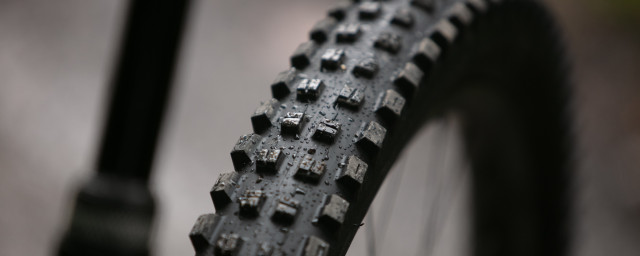The Alpkit Aeronaut is a lightweight tent with an inflatable pole with some features that make it a great setup for bikepacking adventures. It packs down small and is suitable for taller people given the size, although it's not as quick to pitch as some other tents.
- Alpkit Soloist Backpacking Tent review
- Alpkit Cloud Base inflatable sleeping mat review
- How to go bikepacking: a beginner's guide to getting started
The Aeronaut is a new tent for the 2021 summer season. It's a 1-person, 3 season tent that features a single inflatable hoop instead of a main pole, which can benefit some bikepacking applications, with Alpkit also producing a larger 2-person version.
The Aeronaut outer is made from a lightweight, waterproof material with a 3,000mm hydrostatic head (HH) and inner, which can also be separated featuring the same 3000mm HH on the groundsheet.
The claimed weight is a total of 1,200g. The one we have on test, which does not include the optional extra groundsheet, breaks down to a maximum weight of 1,237g.
Outer & inflatable hoop – 756g
Inner & groundsheet – 301g
Pegs (11 total) – 88g
Small rear aluminium support poles – 54g
Peg storage bag – 7g
Tent storage bag – 22g
Spares, including patches – 9g
The tent takes up a pitch of 240cm x 145c and an external height of 100cm when in place. In terms of the internal space available, I measured this when pitched at 220cm in length x 87cm wide and 77cm tall. These make the interior longer than the standard Alpkit Soloist tent and equal to the XL version. There is a porch area, and while it may not be huge, it does make for useable space. Height is quite limited; the 77cm height at the highest point within the inner means sitting upright isn't really an option. However, this is reasonably common for lightweight tents, especially where they are designed to withstand the weather.
The tent is designed to be pitched with the inflatable tube first. When new from the box, the inner and outer sections are separate. While they can be carried, stored and pitched like this, I would strongly suggest keeping them together and pitching as one.
The first pitch of the tent, when inner and outer are separate, is not simple and thankfully something I did before attempting to travel with the tent. While in theory, it is easy, and all that is required is looping through some o-rings and 2 clips, there is no colour coding or directional help, and it took longer than I expected. With the inner and outers left attached, the process is much simpler, although still not perfect or as rapid as some tent designs or other forms of shelter.
Once packed away, the lack of poles of any significant length can be a real bonus for bikepacking. As with many other tents or shelters, the pole would need to carry in an area with a long enough bag, usually a frame bag. In some situations, this may be fine, but not all, especially smaller bikes. The Aeronaut using an inflatable tube instead of a pole, made from thermoplastic polyurethane (TPU), which is the same material that some inners tubes are starting to be manufactured from, such as the Schwalbe Aerothan. The material is robust but can still be patched if required were you unfortunate enough to suffer a puncture. The tube is inflated through a Schrader valve (car type), which is reasonably common for bicycle pumps. However, it is, of course, still worth checking before you first head out.
When testing, I used a Lezyne Alloy Drive hand pump to inflate, which is reasonably small and lightweight. Alpkit does not give a maximum or recommended pressure to inflate to, which is reasonable given that most people will not carry a pressure gauge. Instead, the recommendation is to inflate to ensure it holds its shape. For calm nights the inflatable section only needs enough air to give the tent shape, and I found this took me 6 minutes, with total pitch time taking around 10 minutes. With a larger pump, this could be reduced and also, with more practice, the overall time can be reduced.
When pitching it was possible to peg out initially, then inflate, although all peg points needed to be redone and guy ropes re-tensioned after the tube was inflated. When packing down, I found this incredibly simple and probably the easiest tent to pack that I have used. A large valve opens to remove all the air, at which point assuming it is done with some care, the outer/inner can be packed away into a bag with everything done in under a minute.
The quality of the fabric and small parts, including the aluminium pegs, is good for the price point with strong but lightweight V-shaped alloy pegs that I found easy to use and withstand some abuse when pitching in dry or rocky soil. If you are likely to camp on rocky/rough ground, purchasing the extra footprint would be worthwhile as the groundsheet is thin. I did also have some problems closing the outer zip. The combination of the inflatable pole, which does not always give a perfectly semi-circular shape, combined with the lightweight outer, I found was very easy to catch. I ripped a small section of the zip guard on the first use.
In stronger wind, more air is needed, and while I was fortunate enough to always be pitching in dry weather, I can picture it being more difficult and frustrating to pitch in the rain with nowhere to hide when frantically trying to inflate the tube to shelter. In terms of setup, it certainly isn't the fastest to pitch, and the Alpkit Soloist is probably slightly faster in comparison.
Alpkit class the Aeronaut as a 3-season tent, and while it can withstand some tough conditions, there are some points to be aware of. In higher winds, more pressure is needed in the inflatable tube to give a little extra stability and also, more care needs to be taken to set up and ensure it is well pitched. The big benefit of being inflatable is there is no pole to snap, although, in comparison to some 3 and 4-season tents, it does lack some stability. In heavy rain, I found the outer near the bottom had an area where water tended to pool, needing some adjustment of the rear pole and guy ropes to prevent or at least ease the problem.
Internal storage space is very good, with 3 well placed and generous pockets inside and the porch, which is long enough and still wide enough to be useful. I found the space suitable and large enough for shoes and a helmet, plus enough space inside for lights, batteries and general camping gear. Depending on how tall you are, there is also room to store bikepacking bags at the bottom or within the doorway space.
I found it was possible and actually easier to pack the tent outer & inner into a separate 5-litre bikepacking bag. This also meant I didn't need to carry the outer bag and chose to use a more basic band rather than the peg storage bag. While both options only reduced the weight slightly (to 1,199g), making for a simpler overall solution when packing and unloading.
Value and verdict
At £180, the Aeronaut is not a budget tent. It is also not as expensive as some high-end options with a weight and size that make it a useable bikepacking tent. Perhaps the biggest competitor is the Alpkit Soloist, which is £60 cheaper. Last year, the one tested was almost the same weight at 1,219g for the standard setup and took less time to pitch. Currently, the Aeronaut stands alone as an inflatable tent, but one that is designed for lightweight travel rather than the more usual larger family tents. Among more general tents, the weight and space on offer make it good value with a proper tent, rather than a shelter weighing close to 1.2kg.
The Aeronaut is a standout tent and one that can potentially suit bikepacking with a lightweight, compact overall setup and a side entry that maximises the space. The inflatable pole makes it an excellent option for bikepacking, although the time taken to pitch needs to be considered as it is a little longer than some more standard lightweight tents, and the inflatable pole pushes the price up.





















1 comments
Presumably in the event of a hurried inflation you could bring a sacrifice of a couple of CO2 carts?